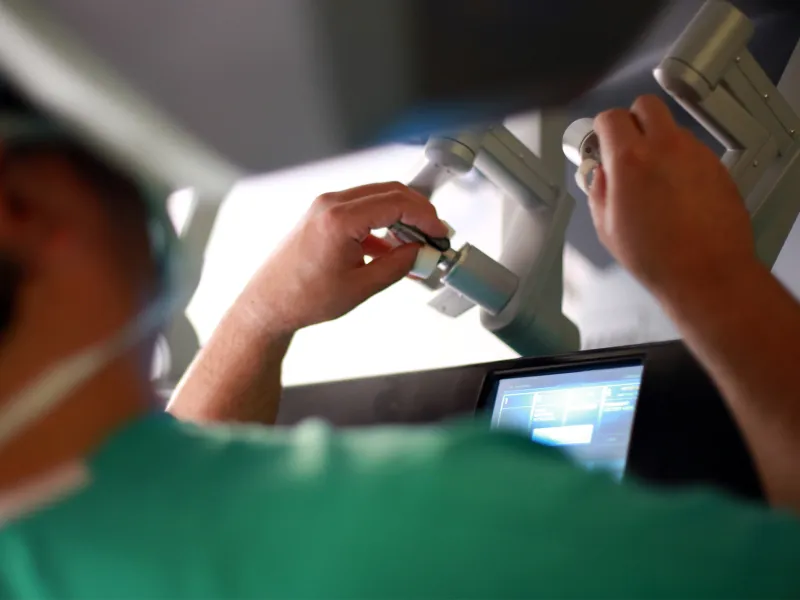
Faster recoveries. Better outcomes.
The expert surgeons at the AdventHealth Digestive Health Institute have a large depth of experience in offering minimally invasive surgery. Many of our surgeons are considered among the top in the region and nation in their fields.
A minimally invasive approach to surgery differs from conventional surgery. It does not involve large cuts made to the skin and muscle. While surgeons must be very skilled to use minimally invasive surgery, it has many benefits for patients. Less pain, less external scaring, less blood loss, a reduced chance for infection and a faster recovery are all reasons a patient should seek out a surgeon who is experienced in offering this approach.
This page discusses minimally invasive surgery in general and does not describe specific procedures. More detail about minimally invasive procedures to treat various digestive conditions can be found in the sections in our Areas of Expertise.
How Minimally Invasive Surgery Works
Minimally invasive surgery is made possible by small, surgical instruments and a light and camera attached to a thin tube, also called a scope. These are inserted through a few small incisions in the abdomen, one of which is usually located in the belly button. Minimally invasive surgery began to become more widely available to U.S. patients in the 1990s, but it has dramatically improved since then. There are now several minimally invasive approaches that are discussed below. Which one is right for you depends on many factors, including your condition, your medical history and what you and your surgeon are comfortable with. Your safety is of the utmost importance, and while the situation is rare, your surgeon may need to switch to an open surgery during your procedure.
What Is Laparoscopic Surgery?
The original minimally invasive surgery was laparoscopic surgery. It is still used today, although many of the instruments have gotten smaller and been improved. Depending on the procedure, laparoscopic surgery involves anywhere from three to five small incisions. These incisions are literally the size of a keyhole on a doorknob.
With most laparoscopic procedures, one of the incisions is in the belly button. The abdomen is filled with carbon dioxide to create enough space for the scope and surgical instruments to move. The surgeon views the surgical site on a monitor near the operating table. To complete the surgery, he or she moves the instruments with attached sticks that protrude from the incisions.
Challenges associated with Laparoscopic Surgery
Laparoscopic surgery can be challenging for surgeons. For one, it does not allow them to move around the surgical site freely as they could with an open procedure. Some surgeries are impossible to perform laparoscopically. The invention of the da Vinci® Surgical System helped fix this problem. The da Vinci allows surgeons to perform what is known as robotic surgery, and it increased the number of procedures that could be offered as minimally invasive surgery.
What Is Robotic Surgery?
With robotic surgery, the physician sits at a booth a few feet away from the patient and sees a high definition view of the surgical site. By gripping the controls located at the booth with both hands, the surgeon moves the instruments of the robot. These controls translate the motions of the surgeon’s hands and fingers exactly as if he or she was operating at the surgical site with miniature hands and instruments. In other words, the surgeon and not the robot is performing the surgery. The robot merely translates the surgeon’s movements from the booth to the operating table.
The benefit of robotic surgery is that surgeons are able to move the instruments with as much freedom they would have with an open surgery. While it still requires a great deal of surgical skill, many surgeons find robotic surgery less difficult than laparoscopic surgery.
What Is Scarless Surgery?
Minimally invasive surgery has continued to improve, and now there are procedures that leave patients without visible scars!
Scarless surgery approaches include:
- Laparo-Endoscopic Single Site (LESS) Surgery–With the development of smaller surgical instruments, it is now possible to place all of these instruments through a single incision, or port. With laparo-endoscopic single site surgery, the camera and the surgical instruments are all inserted through a patient’s belly button. While technically there will be a scar in this area, it will be hidden by the belly button’s natural scar. (If you think about it, the belly button is already a scar.)
- Transoral Surgery–Some procedures are performed through the mouth in much the same way as laparo-endoscopic surgery. In this case, the camera and instruments are placed down the throat and into the esophagus to the surgical site. The patient will have no external scars whatsoever after surgery.
- Transanal Endoscopic Microsurgery (TEM)– The same principle as transoral surgery above works on the other end of the digestive tract as well. This concept has actually been around since the mid-1980s, but, with smaller instruments, is much improved now. TEM can be used to remove rectal polyps. Very few U.S. hospitals offer TEM, but AdventHealth Digestive Health Institute is one of them.
Minimally Invasive and Robotic Surgery Surgical Treatments and Information
-
What to Expect
The AdventHealth Digestive Health Institute Uses Enhanced Recovery After Surgery to Help Patients Experience Fast and Full Recoveries.
-
Preparing Your Body For Surgery
Comprehensive health services are offered at our Digestive Health Institute. We are invested in your long-term health goals.
-
Surgical Treatment for GERD
The AdventHealth Digestive Health Institute offers minimally invasive surgical options for patients with GERD. Learn more about our treatment options today.
-
Esophageal Surgery
At AdventHealth Digestive Health Institute, we offer minimally invasive, robotic esophageal surgery as a cancer treatment option.
-
Pancreatic Surgery
AdventHealth Digestive Health Institute's pancreas surgeons offer minimally invasive pancreatectomy for Pancreatitis, Pancreatic Cysts and Pancreatic Cancer.
-
Liver Surgery
The world-class experts at AdventHealth Digestive Health Institute perform minimally invasive robotic liver cancer surgeries that aren't available at many hospitals.
-
Gallbladder Surgery
Surgeons at the AdventHealth Digestive Health Institute provide advanced, scar-less cholecystectomy for gallbladder pain and gallstones.
-
Bile Duct Diseases and Conditions
AdventHealth Digestive Health Institute Gastroenterologists and Gastrointestinal Surgeons Treat Bile Duct Obstruction (Blocked Bile Duct) and Cholangiocarcinoma (Bile Duct Cancer).
-
Endoscopy for Pancreatic, Bile Duct and Gallbladder Conditions
Gastroenterologists at the AdventHealth Digestive Health Institute use ERCP and Endoscopic Ultrasound to Diagnose and Treat Pancreas, Gallbladder and Bile Duct Diseases.

Fast and Safe Recovery After Surgery
A positive surgical experience starts with knowing what to expect.

Meet Your Dedicated Experts
Our specialists are passionate about providing collaborative care that addresses your unique needs and goals while ensuring you feel informed and supported every step of the way. Learn more about our team and their areas of expertise.
Let Us Help You Feel Whole Again
Whether you’re experiencing new symptoms or want a second opinion on a diagnosis, our dedicated digestive health experts are here to help you find answers and a path forward. Request an appointment today to take charge of your health and get the personal support you need.
